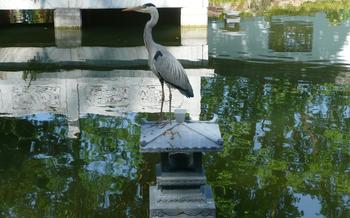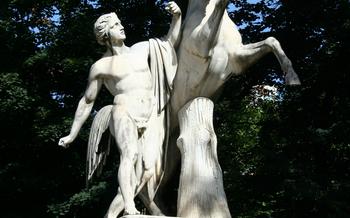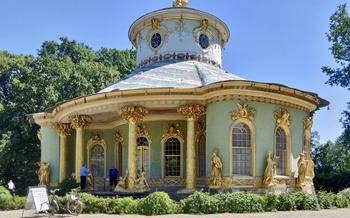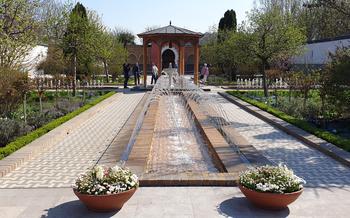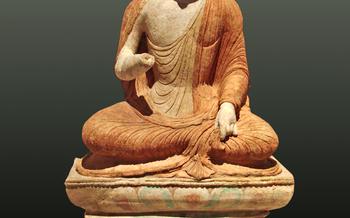
Chinese Garden
- A Haven of Serenity in the Heart of Stuttgart
- The Gateway to Tranquility
- Exploring the Nine Views
- Strolling Through the Garden's Paths
- Discover the Meaningful Sculptures
- Cross the Zigzag Bridge
- Take a Moment by the Lotus Pond
- Visit the Teahouse for a Refreshing Break
- Attend Cultural Events and Workshops
- Seasonal Beauty Throughout the Year
- Plan Your Visit for Optimal Enjoyment
- Capture the Essence of the Garden Through Photography
- Savory Delights at Nearby Restaurants
- Insider Tip: Explore the Neighboring Rosenstein Park
A Haven of Serenity in the Heart of Stuttgart
In the midst of Stuttgart's bustling urban landscape lies a serene oasis that transports visitors to a world of tranquility and beauty: the Chinese Garden. This enchanting garden, meticulously designed according to the principles of traditional Chinese landscaping, offers a sanctuary of peace and tranquility, inviting visitors to escape the hustle and bustle of city life and immerse themselves in the embrace of nature.
The Chinese Garden was conceived in the 1980s as a symbol of friendship between Stuttgart and its Chinese sister city, Nanjing. Created in collaboration with renowned Chinese garden experts, the garden opened its gates in 1993 and has since become a beloved attraction for locals and tourists alike.
Key features of the Chinese Garden include its winding paths, serene ponds, picturesque pavilions, and intricately carved sculptures, all arranged in perfect harmony to create a captivating visual feast. The garden's layout is designed to evoke the essence of traditional Chinese gardens, with its emphasis on balance, asymmetry, and the integration of natural elements.
A visit to the Chinese Garden is a must for anyone seeking a respite from the fast-paced urban environment. Step into this tranquil oasis and let the serene atmosphere wash away your worries as you explore the hidden gems and cultural treasures that await within.
The Gateway to Tranquility
As you approach the Chinese Garden, the imposing entrance gate serves as a majestic portal to a realm of serenity and tranquility. Its architectural style, inspired by traditional Chinese gatehouses, features intricate carvings and a curved roof that sweeps upwards, creating a sense of grandeur and anticipation. Flanked by lush greenery, the gate stands as a symbol of the transition from the bustling city to the peaceful haven that lies within.
Stepping through the gate, you embark on a journey of introspection and tranquility. The path leading into the garden is paved with stones, symbolizing the solid foundation upon which Chinese philosophy and culture are built. As you walk along the path, the hustle and bustle of the outside world fades away, replaced by a sense of calm and serenity. The tranquil atmosphere envelops you, inviting you to leave behind your worries and immerse yourself in the beauty and harmony of the garden.
Exploring the Nine Views
The concept of the Nine Views, or "Jiu Qu Liu Feng," holds a significant place in the design of Chinese gardens. These viewpoints are strategically positioned throughout the garden, offering visitors carefully curated perspectives of its various elements. The nine viewpoints within the Chinese Garden are named after poetic descriptions, each revealing a unique aspect of the garden's layout and symbolism.
As you stroll through the garden, you'll encounter these viewpoints, each providing a different glimpse into its tranquil world. From the "View of the Jade Island" to the "View of the Distant Mountains," each viewpoint unveils a harmonious interplay of water, rocks, pavilions, and trees. The garden's designers have carefully arranged these elements to create a sense of depth and perspective, drawing visitors into the garden's serene embrace.
The Nine Views are not mere aesthetic considerations; they hold deeper meanings and symbolism. Each view represents a specific aspect of Chinese philosophy and culture. For instance, the "View of the Distant Mountains" symbolizes the pursuit of knowledge and enlightenment, while the "View of the Jade Island" represents the search for inner peace and harmony. By contemplating these views, visitors can gain a deeper understanding of Chinese culture and its profound connection to nature.
Strolling Through the Garden's Paths
The Chinese Garden in Stuttgart features a network of winding paths that invite visitors to explore its serene landscapes. These paths are not merely functional routes but integral elements of the garden's design, each with its own significance and purpose.
As you step onto the paths, you will notice their meandering nature, a characteristic that is deliberate and symbolic. In Chinese garden design, paths are often curved to represent the flow of water, symbolizing the fluidity and dynamism of life. This winding layout also creates a sense of mystery and discovery, encouraging visitors to explore every corner of the garden.
There are different types of paths in the Chinese Garden, each serving a specific purpose. Some paths are wide and open, leading visitors to key attractions like the pavilions and the lotus pond. Others are narrower and more secluded, offering a more intimate experience and allowing visitors to connect with the garden's natural beauty.
The paths are designed to guide visitors through the garden in a specific sequence, revealing different perspectives and vistas as they progress. This carefully curated journey allows visitors to appreciate the garden's layout and symbolism in a meaningful way. Along the way, visitors may encounter surprises and hidden delights, such as secluded benches nestled among the trees or unexpected views that open up as they turn a corner.
Strolling through the paths of the Chinese Garden is a meditative experience, inviting visitors to slow down, observe their surroundings, and connect with the tranquility of nature. The winding paths, with their subtle curves and hidden surprises, contribute to the garden's overall charm and create a sense of exploration and discovery that keeps visitors engaged and captivated.
Discover the Meaningful Sculptures
Amidst the serene landscapes of the Chinese Garden, visitors can discover a collection of exquisite sculptures that add depth and symbolism to the garden's ambiance. These sculptures, crafted from various materials such as bronze, stone, and ceramic, depict a diverse range of subjects, from mythical creatures to historical figures.
One of the most striking sculptures is a majestic bronze statue of a dragon, a revered symbol in Chinese culture representing power, wisdom, and good fortune. Its intricate scales, fierce expression, and dynamic pose command attention, capturing the essence of this mythical creature.
Another notable sculpture is a stone carving of a wise old man, known as the "Laughing Buddha." This jovial figure, with his contagious smile and prominent belly, embodies contentment, happiness, and abundance. Visitors often rub his belly for good luck, following a tradition believed to bring prosperity and good fortune.
Throughout the garden, visitors will encounter smaller sculptures depicting animals, birds, and mythical creatures. These sculptures, often hidden among the lush foliage or nestled beside a tranquil pond, add a touch of whimsy and charm to the garden's landscape.
Each sculpture in the Chinese Garden holds a unique story or legend, waiting to be discovered by curious visitors. They enhance the garden's atmosphere, inviting visitors to contemplate the rich symbolism and cultural significance embedded within these works of art.
Cross the Zigzag Bridge
Bridges, in Chinese garden design, hold great significance, representing the transition from one realm to another. The Chinese Garden in Stuttgart features a remarkable Zigzag Bridge that embodies this concept with its unique design. The bridge, constructed from natural stone, meanders across the serene waters, inviting visitors to embark on a journey of introspection and discovery.
The zigzag pattern of the bridge is not merely ornamental; it serves a deeper purpose. In Chinese culture, the zigzag pattern symbolizes the twists and turns of life's path. Crossing the bridge, visitors are reminded that life's journey is not always straightforward but often involves unexpected detours and challenges. The bridge's design encourages visitors to embrace these challenges with resilience and determination.
As visitors traverse the Zigzag Bridge, they are presented with ever-changing perspectives of the garden. The winding path offers glimpses of hidden corners, inviting visitors to explore the garden's secrets and appreciate its intricate beauty from different angles. The bridge acts as a threshold, separating the bustling city from the tranquil oasis of the Chinese Garden, allowing visitors to leave behind the distractions of daily life and immerse themselves in the garden's serene atmosphere.
Standing atop the bridge, visitors can take a moment to admire the stunning views. The lush greenery, delicate blossoms, and shimmering water create a picturesque panorama that soothes the soul. The bridge's unique vantage point offers visitors a chance to capture the essence of the Chinese Garden in a single frame, preserving the memory of their tranquil journey.
Take a Moment by the Lotus Pond
In the heart of the Chinese Garden, tranquility reigns around the serene Lotus Pond. This body of water, adorned with delicate lotus flowers, holds profound significance in Chinese culture. The lotus, with its ability to rise above the mud and bloom with elegance, symbolizes purity, resilience, and spiritual enlightenment.
As you approach the pond, the air becomes still, and the only sounds are the gentle lapping of water against the shore and the occasional chirping of birds. The pond's surface reflects the surrounding pavilions, trees, and clouds, creating a picturesque scene. Take a seat on one of the nearby benches and let the tranquility envelop you.
Observe the various wildlife that calls the pond home. Dragonflies dance above the water, and koi fish swim gracefully beneath its surface. The lotus flowers, with their vibrant colors and delicate petals, add a touch of magic to the serene atmosphere.
The Lotus Pond is an ideal spot for meditation and reflection. Let the peaceful surroundings calm your mind and allow your thoughts to flow freely. Embrace the beauty and symbolism of the lotus, and find inspiration in its journey from mud to blossom.
Visit the Teahouse for a Refreshing Break
Nestled amidst the tranquil beauty of the Chinese Garden, the traditional Chinese teahouse beckons visitors to pause and savor a moment of serenity. Step inside this charming pavilion and immerse yourself in the aromatic world of Chinese tea culture.
The teahouse offers a diverse selection of teas, each with its own unique flavor and significance. From the delicate sweetness of jasmine tea to the invigorating notes of oolong, there's a tea to suit every palate. As you sip your chosen brew, let the soothing ambiance wash away your worries.
The teahouse's tranquil setting provides the perfect backdrop for contemplation and reflection. Surrounded by the garden's lush greenery and the gentle sounds of flowing water, you can easily lose yourself in the moment. Take a break from your busy sightseeing schedule and indulge in the simple pleasure of savoring a cup of tea.
In addition to enjoying a refreshing beverage, the teahouse also offers a chance to learn more about Chinese tea culture. Ask the friendly staff about the different types of tea, their origins, and their significance in Chinese tradition. They'll be happy to share their knowledge and help you discover new favorites.
Whether you're a tea enthusiast or simply looking for a peaceful respite, the teahouse at the Chinese Garden is a must-visit. Take a break from your exploration of the garden and treat yourself to a moment of tranquility and indulgence.
Attend Cultural Events and Workshops
The Chinese Garden in Stuttgart is not just a place to admire its beauty and tranquility; it also serves as a vibrant cultural hub. Throughout the year, the garden hosts a variety of events and workshops that offer visitors an immersive experience of Chinese culture and traditions.
From traditional Chinese music performances to calligraphy classes, tea ceremonies, and more, there's something for everyone to enjoy. These events provide a unique opportunity to learn about Chinese art, customs, and philosophy, while also interacting with locals and other visitors who share a passion for Chinese culture.
Participating in these events and workshops is a great way to deepen your understanding of China's rich cultural heritage and create lasting memories of your visit to the Chinese Garden.
Seasonal Beauty Throughout the Year
The Chinese Garden in Stuttgart is not just a static display of beauty; it's a living, breathing entity that transforms with the seasons, offering visitors a unique experience in every month of the year.
In spring, the garden bursts into life with a riot of colors. The cherry blossoms, magnolias, and azaleas bloom in profusion, painting a picture of delicate pastels against the backdrop of traditional Chinese architecture. The air is filled with the sweet fragrance of flowers, and the sound of birdsong echoes through the garden.
Summer brings a lush green canopy overhead, as the trees and shrubs reach their full height. The lotus pond becomes a haven for dragonflies and damselflies, while the paths are dappled with sunlight and shade. The garden is a perfect place to escape the heat and humidity of the city, and to find a moment of peace and tranquility.
Autumn transforms the garden into a golden wonderland. The leaves of the trees turn brilliant shades of red, orange, and yellow, creating a stunning contrast with the dark green of the pines and firs. The air is crisp and cool, and the garden takes on a magical quality as the days grow shorter.
Winter brings a sense of stillness and serenity to the Chinese Garden. The snow covers the ground and the trees, creating a picturesque winter wonderland. The frozen lotus pond reflects the sky and the surrounding landscape, creating a breathtaking scene. The garden is a popular destination for photographers and nature lovers, who come to capture the beauty of the winter landscape.
Plan Your Visit for Optimal Enjoyment
To fully appreciate the tranquility and beauty of the Chinese Garden, it's essential to plan your visit carefully. The best time to visit is on a weekday morning or early afternoon, when the crowds are fewer. This will allow you to immerse yourself in the garden's serene atmosphere without distractions. If possible, avoid visiting during peak tourist season (July-August) or on weekends when the garden can get crowded.
The Chinese Garden's opening hours vary depending on the season. During the summer months (April-September), it is open from 9 am to 7 pm. In the winter months (October-March), it opens from 9 am to 5 pm. Admission fees are reasonable, with discounts for students, seniors, and families.
The Chinese Garden is wheelchair accessible, with ramps and accessible paths throughout. Visitors with disabilities can also borrow wheelchairs from the garden's information center. To make your visit even more enjoyable, consider joining a guided tour. These tours are offered regularly and provide insights into the garden's history, design, and symbolism.
Capture the Essence of the Garden Through Photography
The Chinese Garden is a photographer's paradise, with countless opportunities to capture the beauty and tranquility of the surroundings. Whether you're a professional photographer or simply enjoy taking snapshots, here are some tips to help you capture the essence of the garden through your lens:
- Choose the Right Location:
- Explore the garden and find spots that offer unique perspectives and compositions.
- Look for interesting angles, reflections, and leading lines.
-
Consider the time of day and lighting conditions to create the desired effect.
-
Capture the Garden's Details:
- Focus on the intricate details of the architecture, sculptures, and plants.
- Get close-up shots to capture the textures and patterns that often go unnoticed.
-
Experiment with different focal lengths to achieve various effects.
-
Play with Light and Shadows:
- Utilize the changing light throughout the day to create dramatic effects.
- Shoot during sunrise or sunset for warm, golden hues.
-
Use shadows to add depth and contrast to your images.
-
Compose Your Shots Carefully:
- Think about the composition of your photos and pay attention to the elements within the frame.
- Use the rule of thirds to create a visually balanced image.
-
Experiment with different perspectives, such as shooting from a low angle or bird's-eye view.
-
Share Your Photos:
- Share your beautiful captures with friends, family, and the online community.
- Use social media platforms to inspire others to visit the Chinese Garden and appreciate its beauty.
- Tag your photos with relevant keywords to increase their visibility.
Savory Delights at Nearby Restaurants
After immersing yourself in the tranquility of the Chinese Garden, take a culinary journey to savor the authentic flavors of Chinese cuisine at nearby restaurants. Within walking distance, you'll find a diverse range of dining options to satisfy your taste buds.
For a truly immersive experience, head to the renowned China Restaurant Peking Ente, known for its exquisite Peking duck and other traditional dishes. The aromatic Peking duck, roasted to perfection, is a must-try for any food enthusiast.
For a more casual dining experience, try the cozy Nudeln & Meehr, specializing in delicious noodle dishes. Their handmade noodles, tossed in flavorful sauces, are a delight for both locals and visitors.
Vegetarians and vegans will find plenty of options at Green Mango, a popular restaurant offering a wide variety of plant-based dishes. Their tofu dishes, bursting with flavor and creativity, are a testament to the versatility of vegan cuisine.
To delve deeper into the local culinary scene, ask the friendly staff at the Chinese Garden for recommendations on hidden gems that serve authentic regional dishes. Whether you crave spicy Sichuan cuisine or delicate Cantonese dim sum, you'll find it all within easy reach of the garden.
So, after your peaceful retreat in the Chinese Garden, embark on a gastronomic adventure and savor the delicious offerings that await you in the surrounding area.
Insider Tip: Explore the Neighboring Rosenstein Park
A Hidden Gem Adjacent to the Chinese Garden
Don't miss the opportunity to explore the neighboring Rosenstein Park, a beautiful green space that offers a variety of attractions. Stroll through the park and admire the lush gardens, serene ponds, and historic monuments. Visit the Wilhelma Zoo, a unique zoological-botanical garden that houses over 11,000 animals from all over the world. The zoo also features a stunning botanical garden with over 7,000 plant species.
In the park, you can also find the Rosenstein Castle, a 14th-century castle that houses the State Museum of Natural History Stuttgart. Explore the museum's collection of fossils, minerals, and animals from the region.
Discover other hidden gems in the area, such as the Mineral Baths, where you can relax and rejuvenate in the thermal waters. Take advantage of the park's bike paths and rent a bicycle to explore the area on two wheels.
Extend your visit to the Chinese Garden by exploring the neighboring Rosenstein Park. With its diverse attractions and natural beauty, it's the perfect place to continue your journey of discovery and create lasting memories.
